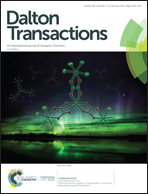Ru(ii)-Peptide bioconjugates with the cppH linker (cppH = 2-(2′-pyridyl)pyrimidine-4-carboxylic acid): synthesis, structural characterization, and different stereochemical features between organic and aqueous solvents†
Abstract
Three new Ru(II) bioconjugates with the C-terminal hexapeptide sequence of neurotensin, RRPYIL, namely trans,cis-RuCl2(CO)2(cppH-RRPYIL-κNp) (7), [Ru([9]aneS3)(cppH-RRPYIL-κNp)(PTA)](Cl)2 (8), and [Ru([9]aneS3)Cl(cppH-RRPYIL-κNp)]Cl (11), where cppH is the asymmetric linker 2-(2′-pyridyl)pyrimidine-4-carboxylic acid, were prepared in pure form and structurally characterized in solution. The cppH linker is capable of forming stereoisomers (i.e. linkage isomers), depending on whether the nitrogen atom ortho (No) or para (Np) to the carboxylate on C4 in the pyrimidine ring binds the metal ion. Thus, one of the aims of this work was to obtain pairs of stereoisomeric conjugates and investigate their biological (anticancer, antibacterial) activity. A thorough NMR characterization clearly indicated that in all cases exclusively Np conjugates were obtained in pure form. In addition, the NMR studies showed that, whereas in DMSO-d6 each conjugate exists as a single species, in D2O two (7) or even three if not four (8 and 11) very similar stable species form (each one corresponding to an individual compound). Similar results were observed for the cppH-RRPYIL ligand alone. Overall, the NMR findings are consistent with the occurrence of a strong intramolecular stacking interaction between the phenol ring of tyrosine and the pyridyl ring of cppH. Such stacking interactions between aromatic rings are expected to be stronger in water. This interaction leads to two stereoisomeric species in the free cppH-RRPYIL ligand and in the bioconjugate 7, and is somehow modulated by the less symmetrical Ru coordination environments in 8 and 11, affording three to four very similar species.



 Please wait while we load your content...
Please wait while we load your content...